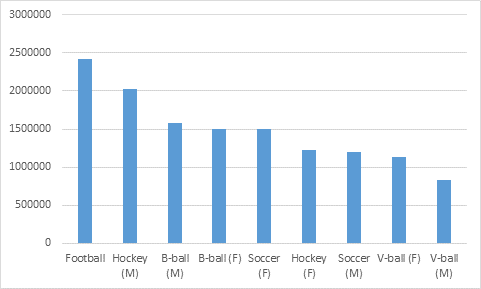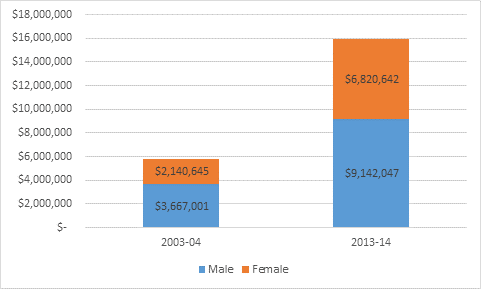Time was, about twenty years ago, Canadian universities didn’t spend money on university athletic scholarships. Then things changed and universities turned on the taps. Today we ask the question: “how’s that going for everyone”?
Well, it’s not going too badly, if you’re an athlete. Just under 5,830 students received athletic scholarships totalling $15,981,189 in 2013-14 – that’s a little over $3,000 a pop. CIS officially recognizes twenty-one sports, nine of which have teams for both genders (eighteen total), plus football which is male-only and rugby and field-hockey which are female-only. However, roughly 85% of the scholarship dollars are concentrated in just nine sports, as shown below in Figure 1. Some have almost no scholarships at all: inter-collegiate curling, for instance, has only 16 scholarships nationally for both sexes.
Figure 1: Top Sports by Scholarship Expenditure, 2013-14
What’s interesting here is that over time, the amount of money spent on Athletics scholarship has been rising quickly and steadily. Even after accounting for inflation, Canadian universities spent nearly three times as much on athletics scholarships ($16 million vs. $5.8 million) in 2013-14 as they did ten years earlier. It’s an interesting choice of expenditure by allegedly cash-strapped institutions.
Figure 2: Total Athletics Scholarships by Gender, 2003-4 vs 2013-4, in constant $2014
I suspect most institutions would probably defend it as a kind of strategic enrolment investment, much the way they defend other kinds of tuition discounting. I mean, does it really matter if you give someone a $5,000 academic entrance scholarship or a $5,000 athletic scholarship? They’re both forms of tuition discounting. And of course, the absolute amounts are trivial. $16 million is only 1% of the total amount of funding given by universities to students (if you include funding to graduate students). And if you want into get into truly ludicrous comparisons, it’s less than what the University of Michigan spends on salaries for its football coaching staff.
A final point to make here is around gender equity. Male and female athletes receive awards at roughly the same rate (45% of athletes of each gender receive an award), which is good. However, imbalances remain in terms of the number of athletics spots for men than women (53% of all athletic team spots are male, compared to about 41% of undergraduates as a whole), and in terms of the size of the average award ($3,286 vs. $2,737). Those results are better than they were a decade ago, and they appear to be slightly better than they are in the US, where actual legislation exists in the form of Title IX to enforce equity in sports, but they are still some ways from equal.



 Tweet this post
Tweet this post

Thank you for raising awareness about the level of support varsity athletes receive at Canadian institutions. There are a few finer points however that would add to the context of this conversation.
First and probably most importantly, the majority of scholarship dollars given to student athletes in Canada is raised by athletic departments, specifically for this purpose. While there are some central university dollars spent on athletic scholarships, the bulk of the funds typically must be raised by the departments, and in some cases, specific teams themselves. So while it may seem that universities are spending much more money on student athletes, in reality athletic departments are raising the majority of these funds, quite often without the direct help of their universities.
Second, there is a good body of research and lived experience that clearly indicates that student athletes are some of the most highly engaged students in a broad spectrum of university endeavours, and post graduation the strongest alumni and largest donors to their individual institutions.
Third, student athletes also make up a large portion of some of the best academic students on their campuses as marked by the number of academic all-Canadians recognized each year.
Lastly, the expectations placed on student athletes to balance course loads, academic requirements, training everyday, heavy competition schedules, expectations regarding their behaviour and additional strains to be engaged with external community groups, all to be afforded the privilege to represent their institution is much more significant than any other student on campus.
I would suggest that the amount of money raised and given to this group of students is worth the investment.
The previous response applies at my own very large Canadian university. It is indeed nice to see a blog on university athletics but it’s too bad it did not include an analysis of the funding source. At my own institution, almost all of the student awards for athletics comes from team and coach fund-raising activities, and from donations from former student athletes who attribute a large part of their positive university experience to having had the opportunity to be a student athlete.
The two commentators, above, have already outlined one of my two points. Most of the money distributed as awards to athletes on many campuses in Canada is raised by the athletes or by the teams and is not coming from university budgets. It’s probably true that some university’s spend no budget dollars at all on athletic awards. It’s an important point in this discussion, mostly because it eliminates the question about whether this is a good way for universities to spend money.
The other point is much less important, but perhaps still important to note. When you say that universities didn’t spend money on athletic awards 20 years ago, we’ll assume that you mean that athletic awards didn’t exist to any significant degree 20 years ago–that’s in view of the first point. But, even that is not really true. My understanding is that this would have been true in Ontario and perhaps in some other jurisdictions, but it was not true in western Canada, where athletic award programs would have been reasonably available and generous at least a decade before that–and, in at least the case I’m familiar with–supported with fundraising by athletes and teams and then matched by provincial government sport funding dollars. Athletic awards have a long-standing tradition in the west.
Interesting article and I agree with the points above. It is true most scholarships are raised by the department/team or come as donations from Alumni specifically for the purpose of awarding an athletic scholarship. Athletes excel in the classroom and on the field and often contribute in many ways to their communities. This leave them little time for part-time jobs through the athletic year. Supporting them with a small scholarship seems reasonable for their efforts and for representing their University so well. Authentic students who are passionate athletes.